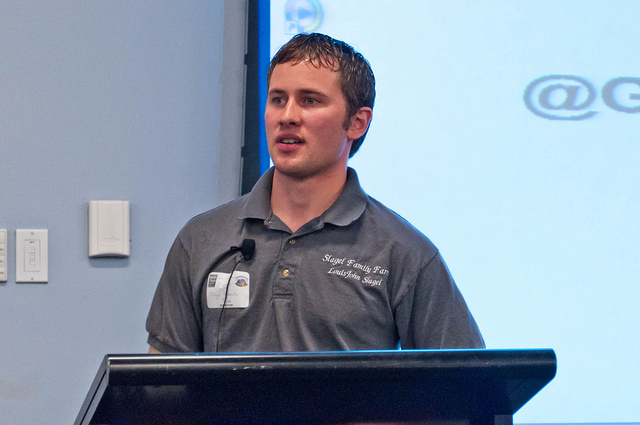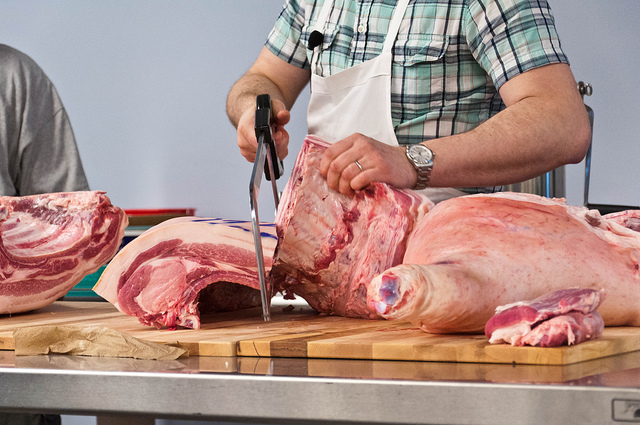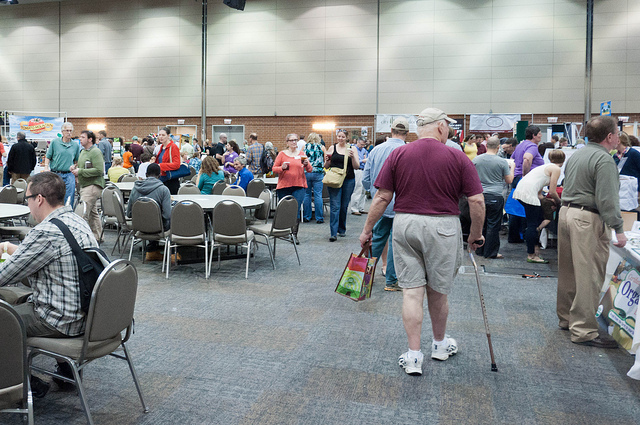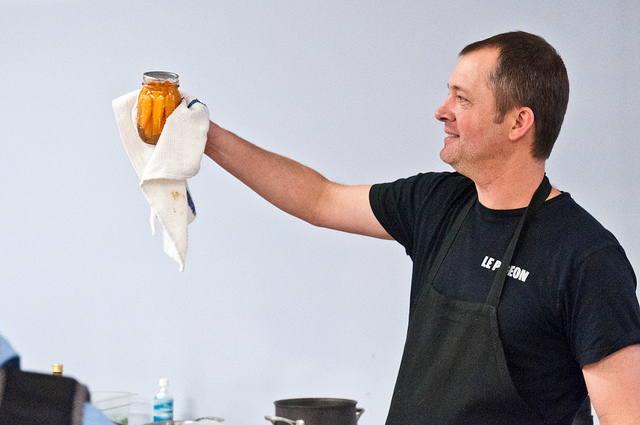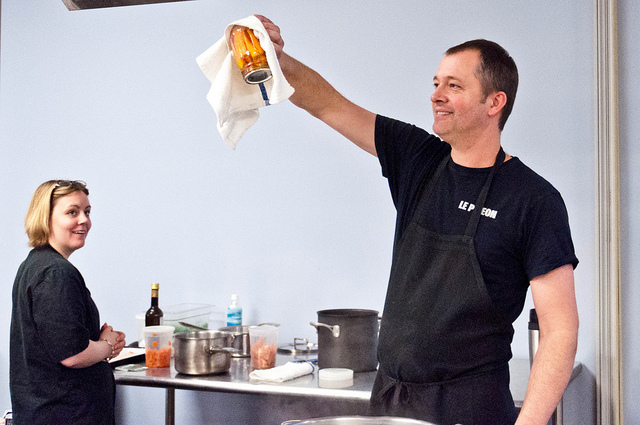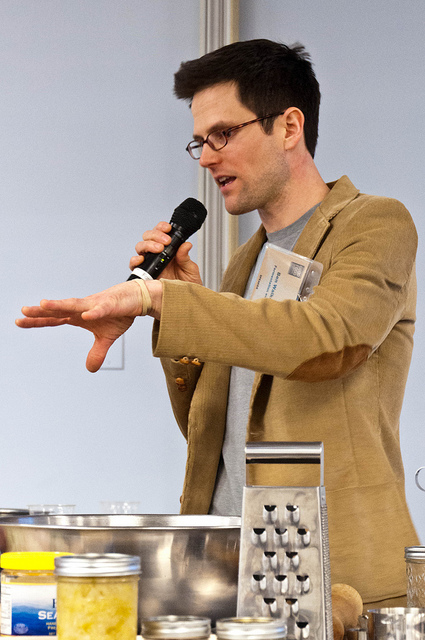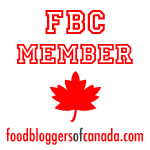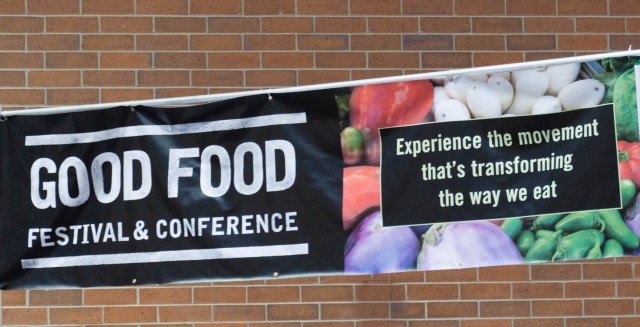
As far as making up for things I’ve missed in years past, I’ve been on a bit of a roll. I finally made it to Restaurant Week (even though I ended up getting the full menu), and just the other day, I made it to the Good Food Festival. I heard of it for the first time last year, when someone posted a card about it on the bulletin board at work. It showed up only a few days before the fest, though, and I couldn’t get the time off. Well, when another card showed up days before the fest this year, I had better luck. Three major things have changed since this time last year: I have a smartphone; I have Saturdays off; and I’m just a bit more awesome.
By the end of my lunch break, I had my ticket. When anyone asked me what I was doing on St. Patrick’s Day, I proudly told them I was going to learn how to butcher a whole pig and make sausage out of it. In response, I saw a lot of faces of disgust. I’m not sure if they were put off by the idea of dealing with an animal corpse, or at my particular eagerness to do so. Whatever the case, I find getting drunk at 10am and watching them dump green dye into the Chicago River far more repulsive. Matter of opinion, I guess…
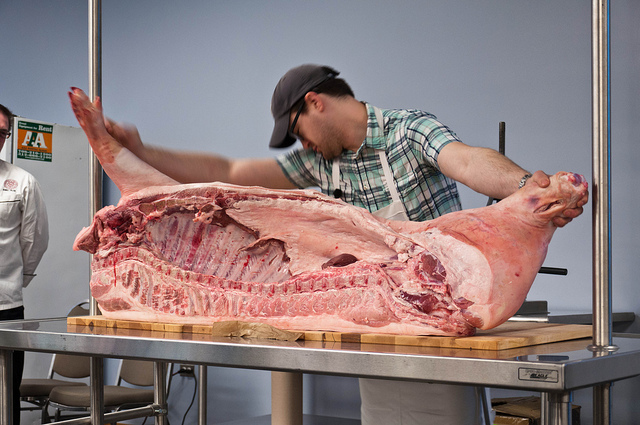 So what is this Good Food Festival? It’s a chance for all sorts of local food suppliers and enthusiasts to come together and share their love of food. It’s also a place to learn, with workshop topics ranging from cooking techniques to local community building. I only went on the final, “festival” day. On the day before, there’d been a trade show and policy summit for those involved in the local food industry and local food politics, and on the day before that was a financing conference focused on growing local food businesses.
So what is this Good Food Festival? It’s a chance for all sorts of local food suppliers and enthusiasts to come together and share their love of food. It’s also a place to learn, with workshop topics ranging from cooking techniques to local community building. I only went on the final, “festival” day. On the day before, there’d been a trade show and policy summit for those involved in the local food industry and local food politics, and on the day before that was a financing conference focused on growing local food businesses.
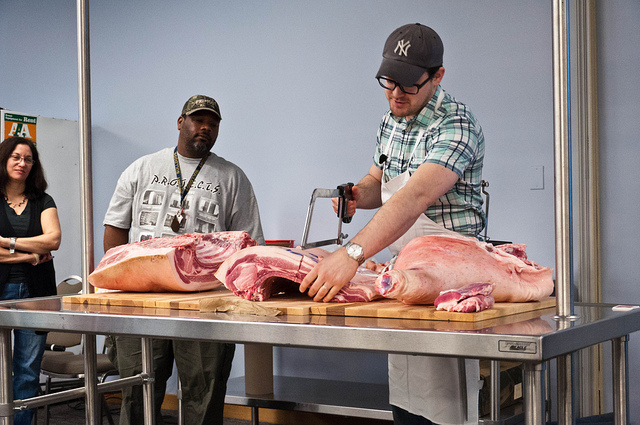
For me, the day started with an in-depth and really fun 3-hour workshop called “The Whole Animal: Butchering and Sausage Making Demo with Rob Levitt.” That name was so familiar to me, and as soon as he started talking I realized it was the Rob Levitt of mado, the (sadly short-lived) Chicago restaurant that was known for a “snout-to-tail” approach and a dedication to local and sustainable food sourcing. Though I never made it to mado, Rob and I actually have a mutual friend, and when he stayed with us a couple of years ago, he brought home some mado leftovers, which were surprisingly plentiful and (unsurprisingly) absolutely delicious.
Anyway, there was half on a pig on the table, and Rob got to butchering it. He demonstrated his craft, pointing out when his method deviated from tradition and explaining all the reasons for his techniques. We heard from LouisJohn Slagel, of Slagel Family Farms, where this very pig was born, raised, and slaughtered. Unlike big, commercial farms, Slagel still does things the old-fashioned way. The pigs are bred naturally (no artificial insemination), eat vegetarian diets (with feed grown on the farm), and a live a free-range lifestyle . There’s no hormones or antibiotics used, and the slaughterhouse uses safe and humane methods.
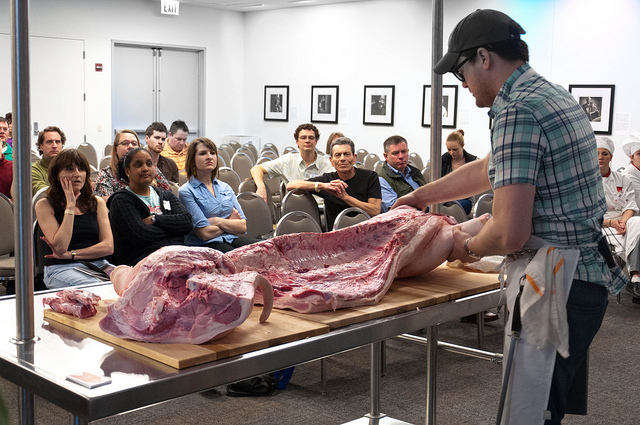
Since mado closed, Levitt and his wife now operate The Butcher & Larder, which as their website says, is “Chicago’s first sustainable, all whole animal butcher shop.” The issue of price was brought up, as a common criticism of locally sourced goods is its higher price tag. As both Levitt and Slagel explained, the meat we’re used to at supermarkets is cheaper because of the methods used by big meat producers. Smaller, local farms can’t compete with the big names when it comes to price, but as I see it, you’re paying for the respect for both the animal and the consumer that is just unheard of in commercial operations. Levitt also pointed out that the typical American diet simply involves too much meat.
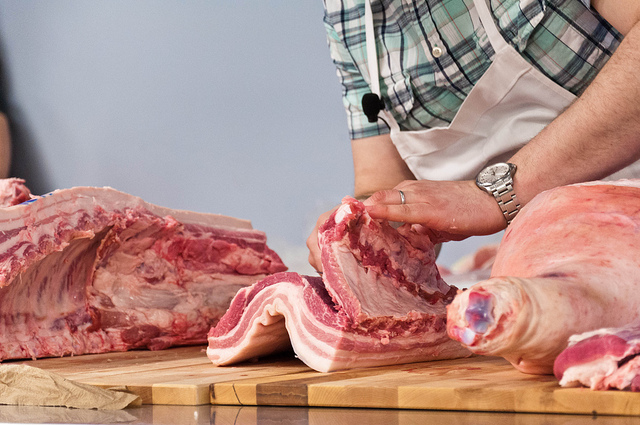 I was a vegetarian for many years, and I’ve been eating meat again for about 5 years now. When I reintroduced meat into my diet, I did so with a much greater respect for what I was eating. In America, we tend to be so disconnected from origins of our food. I’m certainly guilty of this too. But whenever someone gave me a look of disgust when I told them I’d be attending this workshop, I pointed out that they’d be unlikely to be so unwelcoming to a thick, juicy pork chop. We’re just so used to not thinking about what our food starts out as.
I was a vegetarian for many years, and I’ve been eating meat again for about 5 years now. When I reintroduced meat into my diet, I did so with a much greater respect for what I was eating. In America, we tend to be so disconnected from origins of our food. I’m certainly guilty of this too. But whenever someone gave me a look of disgust when I told them I’d be attending this workshop, I pointed out that they’d be unlikely to be so unwelcoming to a thick, juicy pork chop. We’re just so used to not thinking about what our food starts out as.
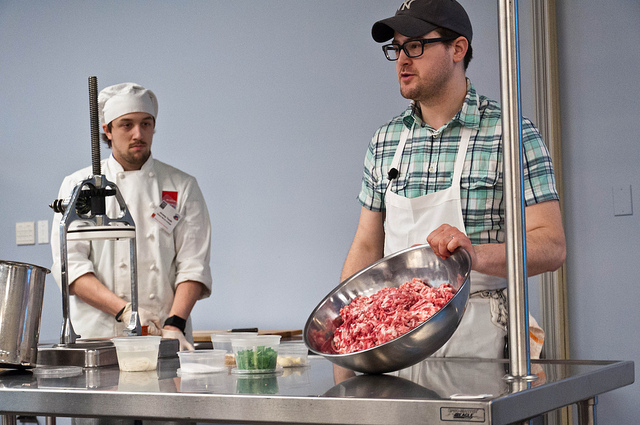
I’m not going to pretend I get all my meat from local sources; currently, admittedly, I almost never do. This is almost purely a price-based decision. But attending this workshop definitely left these issues fresh in my mind, and especially with places like The Butcher & Larder nearby, I have no excuse but to make more of an effort.
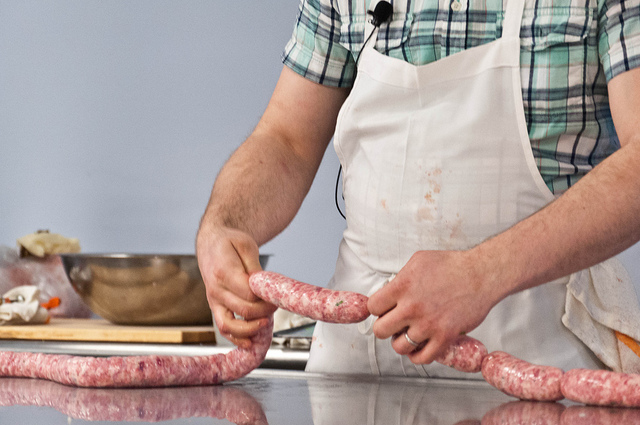
After the pig was masterfully butchered, Levitt taught us the basics of sausage making. If you’re in Chicago and interested such things, check out The Butcher & Larder events page to find out about upcoming workshops or to schedule a demo.
By the end of the workshop, I was starving. I checked out the exhibit hall, which was full of local vendors, farmers, food organizations, and more. I bought an Italian beef sandwich made from local meat courtesy of Birky Family Farms, and tasted a whole bunch of local goodies. Once my stomach was full of tasty local grub, and my bag was full of business card and pamphlets, I headed back to the workshops.
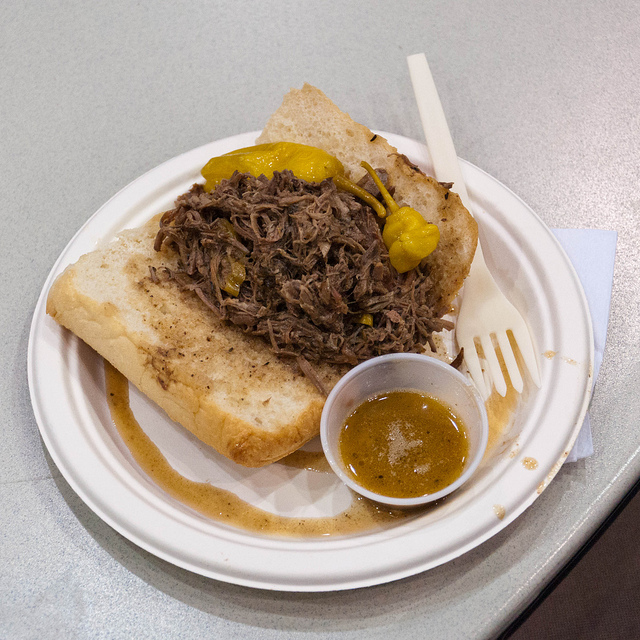
I sadly missed Paul Virant’s workshop on canning and pickling (I wish there was more time between workshops to enjoy the exhibit hall). I did, however, catch the last 5 minutes, in which, short on time, he tried to demonstrate that a jar was sealed without waiting long enough… and spilled it all over the table. While I didn’t get a photo of that, I did get a photo of his redemption, when, after the tell-tale “pop” was heard, he confidently, and with a great sense of humor, flipped the second jar over with success.
Next was a workshop on fermented foods by beekeeper, herbalist, and fermentation enthusiast Ben Walker, with help from The Local Beet’s Ron Gardner. Here we learned why fermented foods are important to our health, and how to make an easy, delicious sauerkraut at home.
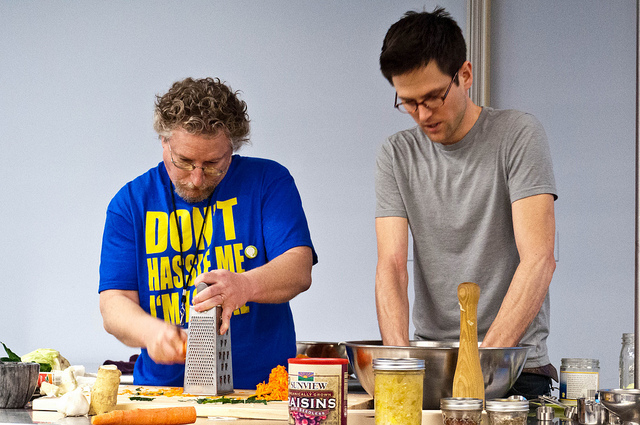
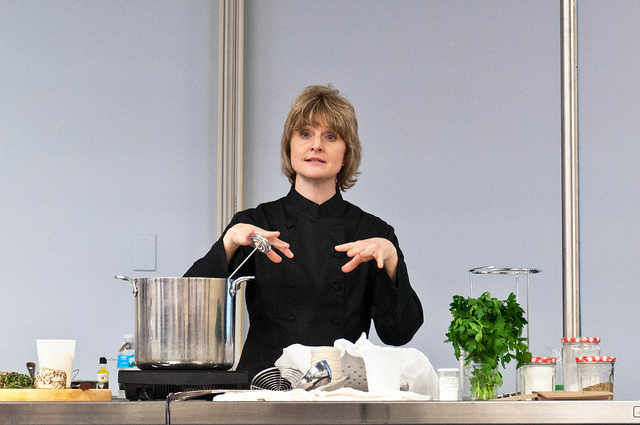 I was considering going to the “Local and Organic Eating on a Dime” or “Small-Space Gardening” workshops in the last time slot of the day, but as someone addicted to making things from scratch, I couldn’t pass up the “Home Cheesemaking” demonstration. Jennifer Downing of Nourish Cooking School taught us the basic processes behind cheesemaking, and showed us how to make simple soft cheeses like ricotta. We also heard Katie Hedich talk about her successes with La Clare Farms (where Downing gets her goats milk). At the end, we got to try some cheeses that Downing had prepared ahead of time. All of them (chevres, mascarpone, fresh mozzarella) were so fresh-tasting and delicious!
I was considering going to the “Local and Organic Eating on a Dime” or “Small-Space Gardening” workshops in the last time slot of the day, but as someone addicted to making things from scratch, I couldn’t pass up the “Home Cheesemaking” demonstration. Jennifer Downing of Nourish Cooking School taught us the basic processes behind cheesemaking, and showed us how to make simple soft cheeses like ricotta. We also heard Katie Hedich talk about her successes with La Clare Farms (where Downing gets her goats milk). At the end, we got to try some cheeses that Downing had prepared ahead of time. All of them (chevres, mascarpone, fresh mozzarella) were so fresh-tasting and delicious!
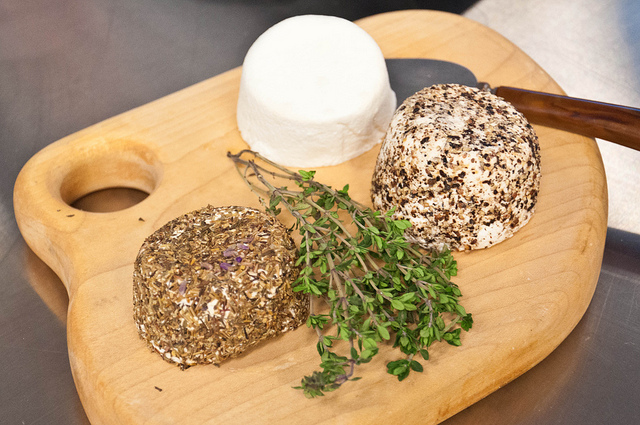
By the end of the 9 hour day, I was pretty exhausted, but left the festival with lots of great notes and ideas. I left feeling much more connected with my local food community, and very encouraged to try harder to source more of my ingredients locally. It can be hard here in the middle of the country, with our drastic seasons and considerable distance from those fancy oceans you coastal dwellers have, but it’s definitely possible and increasingly easy and affordable.
Click here for a gallery of all of my photos from the 2012 Good Food Festival.
Be sure to check out the Good Food Festival and Conference website for more information and to find out about future events in Chicago and more!
